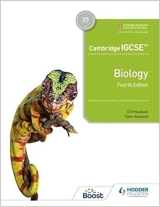Chapter 19. Co-ordination
Page 164
1. A nerve fibre is part of a single cell and is microscopic (about 1-20µ diameter). A nerve
consists of hundreds of nerve fibres bundled together in a protective sheath and
is visible to the naked eye (in dissections).
2. a Sensory and motor neurones are both single cells consisting of a cell body with a nucleus
and a long nerve fibre usually running between the central nervous system and a peripheral
structure.
b Both neurones conduct electrical impulses.
Sensory neurones originate in a sensory structure and conduct impulses towards the central
nervous system. Their cell bodies are not terminal though still in the central nervous system.
Motor neurones have their cell bodies in the central nervous system. They conduct impulses
away from the CNS to an effector organ.
3. a A nerve fibre can carry only sensory or motor impulses.
b A nerve (a mixed nerve) can carry both sensory and motor fibres and therefore can transmit
both sensory and motor impulses.
Page 165
1. Fig. 19.7 a Cell bodies 2 b Synapses 1
Fig. 19.9 a Cell bodies 7 b Synapses 5 (6 if you count the top one as 2)
2. All nerve impulses are the same in principle. You could not distinguish which receptor they
came from. The sensation you experience depends on which part of the brain the impulse is
sent to.
Page 167
1. d receptor organ stimulated; b impulse travels in sensory fibre; e impulse crosses synapse;
a impulse travels in motor fibre; c effector organ stimulated.
2. a Sneezing; sensors in the nose; effectors in diaphragm, rib muscles and muscles in the
upper part of the trachea.
b Blinking; receptors in the retina of the eye; effectors, muscles in the eyelids.
c Contraction of the iris; receptors in the retina; effectors, circular muscles (sphincter muscles)
in the iris.
3. The tongue has receptors for the chemicals which produce the taste sensations as well as sensors
for temperature and pain. It is an effector because its muscles can move it about to manipulate food,
initiate swallowing and control speech.
4. Coughing as a reaction to particles in the trachea or an intense ‘tickle’ is a reflex action. You
cannot stop it. Coughing to clear the throat is a voluntary action.
5. Responses to commands such as ‘lie down’, ‘come here’, and to actions such as a lead being
picked up or a plate being rattled are conditioned reflexes.
Page 169
1. The cell bodies are concentrated in the grey matter so this is where synapses will occur.
2. Depending on the extent of the damage; no sensory information (touch, pressure etc.) would
reach the brain from the legs and lower abdomen. Motor function below the area of damage
would be lost so that there could be no leg movement, and control over bladder and rectum
would be lost.
3. a Fore-brain; smell. Mid-brain; sight. Hind-brain; hearing, balance and skin senses.
b The medulla.
4. Sensors in the cochlea of the ear detect the sound waves and send impulses via the auditory
nerve to the hind-brain.
The hind-brain then transmits impulses via neurones and synapses to the cerebral cortex
which, in turn, sends motor impulses to the neck muscles which turn the head.
Page 172
1.
| Endocrine system (examples) |
Nervous system (examples) |
Secretion of oestrogen.
Transport of oestrogen to ovary.
Rate of blood flow from ovary to pituitary.
Oestrogen is carried to all parts of the body but affects only the uterus and pituitary gland.
Secondary sexual characteristics |
Spinal reflex.
Impulses from sensors to brain.
Impulse from sensor to brain takes milliseconds.
Motor neurone in reflex arc sends impulse but affects only the uterus and pituitary directly to effector organ.
Reflex response. |
2. The ovaries produce ova but they also secrete the hormone, oestrogen.
The testes produce sperms but they also secrete the hormone. testosterone.
3. Too much insulin results in a reduction in the blood glucose level, which can impair the
function of other organs such as the brain.
Too little insulin allows the blood glucose levels to rise. This effect and related effects can
produce the symptoms of diabetes.
4. If an ovum is fertilized, the ovary produces the hormone progesterone. This hormone or its
breakdown products are excreted and appear in the urine, where they can be detected.
|
Downloads
Download the answers in PDF format below
Section 1, Chapters 1-5
Section 2, Chapters 6-9
Section 3, Chapters 10-12
Section 3, Chapters 13-17
Section 3, Chapters 18-20
Section 4, Chapters 21-24
Section 5, Chapters 25-27
Section 5, Chapters 28-29
Section 6, Chapters 30-34
Section 6, Chapters 35-37
Section 7, Chapters 38-39
Section 8, Chapters 40-41
|
